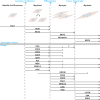The myogenic kinome: protein kinases critical to mammalian skeletal myogenesis
- PMID: 21902831
- PMCID: PMC3180440
- DOI: 10.1186/2044-5040-1-29
The myogenic kinome: protein kinases critical to mammalian skeletal myogenesis
Abstract
Myogenesis is a complex and tightly regulated process, the end result of which is the formation of a multinucleated myofibre with contractile capability. Typically, this process is described as being regulated by a coordinated transcriptional hierarchy. However, like any cellular process, myogenesis is also controlled by members of the protein kinase family, which transmit and execute signals initiated by promyogenic stimuli. In this review, we describe the various kinases involved in mammalian skeletal myogenesis: which step of myogenesis a particular kinase regulates, how it is activated (if known) and what its downstream effects are. We present a scheme of protein kinase activity, similar to that which exists for the myogenic transcription factors, to better clarify the complex signalling that underlies muscle development.
Figures



References
LinkOut - more resources
Full Text Sources
Other Literature Sources
Molecular Biology Databases

